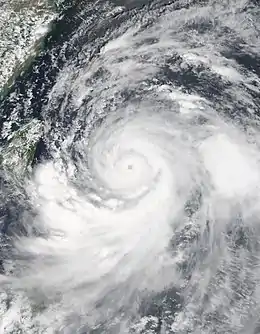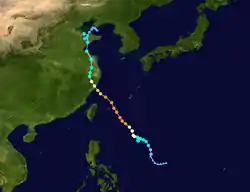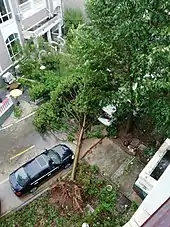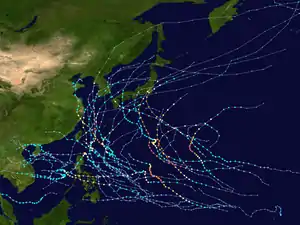Typhoon Lekima
Typhoon Lekima, known in the Philippines as Typhoon Hanna, was the costliest typhoon in Chinese history.[1] The ninth named storm of the 2019 Pacific typhoon season, Lekima originated from a tropical depression that formed east of the Philippines on July 30. It gradually organized, became a tropical storm, and was named on August 4. Lekima intensified under favorable environmental conditions and peaked as a Category 4–equivalent Super typhoon. However, an eyewall replacement cycle caused the typhoon to weaken before it made landfall in Zhejiang late on August 9, as a Category 2–equivalent typhoon. Lekima weakened subsequently while moving across Eastern China, and made its second landfall in Shandong on August 11.
| Typhoon (JMA scale) | |
|---|---|
| Category 4 super typhoon (SSHWS) | |
 Typhoon Lekima at peak intensity above Ryukyu Islands on August 8 | |
| Formed | August 2, 2019 |
| Dissipated | August 14, 2019 |
| (Extratropical after August 14) | |
| Highest winds | 10-minute sustained: 195 km/h (120 mph) 1-minute sustained: 250 km/h (155 mph) |
| Lowest pressure | 925 hPa (mbar); 27.32 inHg |
| Fatalities | 105 total |
| Damage | $9.28 billion (2019 USD) |
| Areas affected | Caroline Islands, East China, Philippines, Ryukyu Islands, Taiwan, Malaysia |
| Part of the 2019 Pacific typhoon season | |
Lekima's precursor enhanced the southwestern monsoon in the Philippines, which brought heavy rain to the country. The rains caused three boats to sink and 31 people died in this accident. Lekima brought catastrophic damage in mainland China, with a death toll of 71 people and more than CN¥65.37 billion (US$9.26 billion) in damages. The system also caused minor damage in Ryukyu Islands and Taiwan. In Malaysia, the typhoon brought up strong tides and partially destroyed the coastal areas of Penang.
Meteorological history

On August 2, the Japan Meteorological Agency (JMA) began to monitor a tropical depression which developed over the Philippine Sea.[2] The next day, the PAGASA would later name it as "Hanna".[3] The system slowly developed while moving northward. The Joint Typhoon Warning Center (JTWC) also monitored the system and gave the identifier 10W early on August 4.[4] The JMA upgraded the system to a tropical storm and assigned the name Lekima at 6:00 a.m. UTC that day.[5] The JTWC followed suit later that day. Though Lekima was affected by moderate wind shear, warm waters of 31 °C (88 °F) and good outflow channel allowed Lekima to slowly intensify, and Lekima became almost stationary due to the absence of steering current.[6]
On August 6, Lekima steered by a subtropical ridge to the northeast and accelerated to the northwest,[7] and the JMA upgraded Lekima to a severe tropical storm. Later that day, both JMA and JTWC upgraded Lekima to a typhoon, after the system developed a central dense overcast.[8] As Lekima continued to move northwestward, the system moved into an area of low wind shear, and it started a process of rapid intensification on August 7. The eye became evident on satellite imagery.[9] On August 8, the JTWC upgraded Lekima to a super typhoon, and stated that the system had acquired some of the annular characteristics.[10] Later that day, the JMA stated that Lekima attained maximum sustained winds of 195 km/h (121 mph).[11] At the same time, Lekima passed between Miyako-jima and Tarama-jima.[12]
Shortly thereafter, Lekima began an eyewall replacement cycle. The typhoon developed a concentric eyewall, as seen from the radar.[13][14] This cycle also caused the motion of Lekima slightly veered to the north,[15] and the JTWC downgraded Lekima back to typhoon late on August 8.[16] The same day, PAGASA reported that "Hanna" exited their Philippine Area of Responsibility.[17] Environmental conditions in East China Sea became less favourable, causing Lekima to slowly weaken while approaching East China. At 1:45 a.m. China Standard Time (UTC+08:00) August 10, Lekima made landfall in Wenling, Zhejiang with two-minute sustained winds of 185 km/h (115 mph).[18] Lekima quickly weakened and turned to the north, along the western side of the subtropical ridge.[19] Lekima dropped below typhoon intensity early on August 10, and weakened further to a tropical storm later that day. Lekima emerged into the Yellow Sea early on August 11,[20] and made second landfall in Xihai'an, Qingdao, Shandong at 8:50 p.m. CST, with two-minute sustained winds of 85 km/h (53 mph).[21] The JTWC issued its final warning to the system around that time.[22] Lekima meandered over the Shandong Peninsula and Bohai Sea throughout August 12, and the JMA downgraded it to a tropical depression later that day.[23]
Preparations and impact
| Rank | Typhoon | Season | Damage (2019 USD) |
|---|---|---|---|
| 1 | Mireille | 1991 | $18.8 billion |
| 2 | Hagibis | 2019 | $15 billion |
| 3 | Jebi | 2018 | $13.2 billion |
| 4 | Songda | 2004 | $12.6 billion |
| 5 | Fitow | 2013 | $11.4 billion |
| 6 | Faxai | 2019 | $10 billion |
| 7 | Saomai | 2000 | $9.35 billion |
| 8 | Lekima | 2019 | $9.28 billion |
| 9 | Prapiroon | 2000 | $9.12 billion |
| 10 | Bart | 1999 | $8.82 billion |
| Source: | |||
Philippines
As Lekima moved northwestward and approached the northern part of the Philippines, PAGASA issued PSWS#1 to Batanes and the Babuyan Islands late on August 6.[24] These warnings were lifted after Lekima left the Philippine Area of Responsibility.[25]
Though Lekima, locally known as "Hanna", did not directly affect the Philippines, it enhanced the southwest monsoon which caused heavy rain to the nation. Three boats sank in Guimaras Strait; 31 people died and three were left missing.[26] Heavy rains also caused flooding in Metro Manila.[27] Classes of numerous cities were suspended on August 5.[28] A motorboat carrying 10 passengers capsized off the coast of Mactan Island in the early morning of August 7.[29] To the south, waves from Lekima displaced more than 1,300 people in Davao City.[30] Agricultural damage in Central Luzon was at ₱80.5 million (US$1.55 million).[31]
Ryukyu Islands
As Lekima approached the southwestern Ryukyu Islands, Ishigaki-jima and Miyako-jima received a storm warning. The JMA urged the residents on these islands to beware of high waves, heavy rain, and sudden gusts.[32] Gusts in Miyako-jima reached 168 km/h (104 mph), while gusts in Shimojishima Airport and Iriomote-jima reached 156 km/h (97 mph) and 125 km/h (78 mph) respectively.[33] Six people were injured during the storm, and thousands of families suffered from power outages.[34] Hundreds of flights and passenger ship trips were cancelled on August 7–9, mainly in Miyako-jima and Ishigaki-jima, affecting thousands of passengers.[35][36] Agricultural damage across the island chain was JP¥347 million (US$3.29 million).[37]
Taiwan
Taiwan's Central Weather Bureau (CWB) issued a sea warning on August 7.[38] As Lekima continued to approach the island, the CWB issued a land warning to the northern part of Taiwan early on the next day, locally.[39] The CWB lifted the land warning late on August 9,[40] and lifted the sea warning early on the next day, after Lekima made landfall in East China.[41] On late August 8, school and work were cancelled for the next day in eight municipalities and counties in the northern part of Taiwan and in the Matsu Islands.[42] Hundreds of flights and ships were cancelled and delayed.[43]
Throughout Taiwan, Lekima killed two people and injured 15 others. More than 80,000 families suffered power outages.[43] On August 8–9, Wufeng Township recorded a rainfall total of 385 mm (15.2 in), while rainfall in Taichung amounted to 355.5 mm (14.00 in).[44] Lekima's downdraft affected Kinmen on August 9, where a farmland recorded temperature of 39.9 °C (103.8 °F), setting the national record for the second highest temperature. Jinfeng Township also recorded a temperature of 36.8 °C (98.2 °F).[45] Institutional damage of Lekima, along with a magnitude 6.0 earthquake reached NT$5.24 million (US$167,000).[46]
Mainland China

Striking East China as a super typhoon, according to China Meteorological Administration, Lekima wrought major damage across numerous provinces. In all, the typhoon killed 71 people.[47] Damage nationwide exceeds CN¥65.37 billion (US$9.26 billion).[1] Zhejiang was the worst hit province; 45 people died in the province, and economic loss reached CN¥45.38 billion (US$6.43 billion).[1] Most of those killed died because of landslides in Yongjia County, and the landslides blocked a river. Water levels rose 10 m (33 ft) in ten minutes, and many residents could not evacuate in time.[48] Wenling recorded peak wind gusts of 221 km/h (137 mph), while daily rainfall in Beilun District amounted to 291 mm (11.5 in).[1]
Lekima also brought significant effects in Shandong, where 5 people were killed, 7 remain missing, and the damage statewide amounted to over CN¥16 billion (US$2.27 billion).[1] Because Lekima looped around Shandong for days, it brought heavy rainfall in the province. Daily rainfall in Linqu County reached 386.7 mm (15.22 in).[49]
Malaysia
The tail front of Lekima stretched south to Malaysia and struck the northern states of the Malay Peninsula on August 9, which killed a person, left one missing while injuring ten others in the states of Kedah, Penang and Perak.[50] The storm also caused damage to 329 schools, and the damage was about RM20 million (US$4.77 million). Wind speeds in some areas were recorded at 100 km/h (62 mph). Hundreds of trees were uprooted.[51] 1,358 houses in Kedah were damaged by Lekima.[52] Total damage in Malaysia reached RM60.2 million (US$14.4 million).[53]
Retirement
Due to the severe impact in China, the name Lekima was retired during the 52nd annual session of the ESCAP/WMO Typhoon Committee in February 2020. A replacement name will be chosen in early 2021.[54]
See also
References
- 利奇马酿成我国近年来最严重台风灾害 (in Chinese). 中国气象爱好者. August 18, 2019. Retrieved August 19, 2019.
- 台風8号 5日(月)から西日本に接近・上陸のおそれ (in Japanese). Weather News. August 3, 2019. Retrieved August 10, 2019.
- Severe Weather Bulletin No. 1 for Tropical Depression "HANNA" (PDF) (Report). National Disaster Risk Reduction and Management Council. August 3, 2019. Retrieved September 14, 2019.
- "Tropical Depression 10W (Ten) Warning NR 001". Joint Typhoon Warning Center. August 4, 2019. Archived from the original on August 4, 2019. Retrieved August 10, 2019.
- 令和元年 台風第9号に関する情報 (in Japanese). Japan Meteorological Agency. August 4, 2019. Archived from the original on August 4, 2019. Retrieved August 10, 2019.
- "Prognostic Reasoning for Tropical Storm 10W (Lekima) Warning NR 08". Joint Typhoon Warning Center. August 5, 2019. Archived from the original on August 5, 2019. Retrieved August 10, 2019.
- "Prognostic Reasoning for Tropical Storm 10W (Lekima) Warning NR 11". Joint Typhoon Warning Center. August 6, 2019. Archived from the original on August 6, 2019. Retrieved August 10, 2019.
- "Prognostic Reasoning for Typhoon 10W (Lekima) Warning NR 12". Joint Typhoon Warning Center. August 6, 2019. Archived from the original on August 6, 2019. Retrieved August 11, 2019.
- "Prognostic Reasoning for Typhoon 10W (Lekima) Warning NR 16". Joint Typhoon Warning Center. August 7, 2019. Archived from the original on August 8, 2019. Retrieved August 11, 2019.
- "Prognostic Reasoning for Super Typhoon 10W (Lekima) Warning NR 18". Joint Typhoon Warning Center. August 8, 2019. Archived from the original on August 8, 2019. Retrieved August 11, 2019.
- 大型の台風9号 猛烈な勢力に発達 (in Japanese). Japan Meteorological Society. August 8, 2019. Archived from the original on August 8, 2019. Retrieved August 11, 2019.
- 台風9号、沖縄・先島諸島を直撃 暴風雨災害に厳重警戒を (in Japanese). Tokyo Shimbun. August 8, 2019. Archived from the original on August 10, 2019. Retrieved August 11, 2019.
- Yang, Yi-Ting; Kuo, Hung-Chi; Hendricks, Eric A.; Peng, Melinda S. (2013-03-18). "Structural and Intensity Changes of Concentric Eyewall Typhoons in the Western North Pacific Basin". Monthly Weather Review. 141 (8): 2632–2648. Bibcode:2013MWRv..141.2632Y. doi:10.1175/MWR-D-12-00251.1. ISSN 0027-0644.
- Cowan, Levi [@TropicalTidbits] (August 8, 2019). "Lekima has been undergoing a very slow eyewall replacement cycle since yesterday morning" (Tweet). Retrieved August 12, 2019 – via Twitter.
- Belles, Jonathan (August 9, 2019). "When Hurricanes Dance: How Trochoidal Wobble Saved Some Japanese Islands From the Worst of Typhoon Lekima". The Weather Channel. Retrieved August 12, 2019.
- "Prognostic Reasoning for Typhoon 10W (Lekima) Warning NR 20". Joint Typhoon Warning Center. August 8, 2019. Archived from the original on August 9, 2019. Retrieved August 11, 2019.
- Severe Weather Bulletin No. 16 for Typhoon "HANNA" (LEKIMA) (PDF) (Report). National Disaster Risk Reduction and Management Council. August 9, 2019. Retrieved September 14, 2019.
- Tang, Tao (唐弢) (August 10, 2019). 超强台风“利奇马”登陆浙江温岭 浙江转移70余万人 (in Chinese). Xinhua News. Retrieved August 11, 2019.
- "Prognostic Reasoning for Typhoon 10W (Lekima) Warning NR 25". Joint Typhoon Warning Center. August 10, 2019. Archived from the original on August 10, 2019. Retrieved August 11, 2019.
- Li, Kaixiang (李凯祥) (August 11, 2019). “利奇马”即将二次登陆|台风48小时全记录 (in Chinese). The Beijing News. Retrieved August 11, 2019.
- Ye, Jing (叶婧); Zhang, Wuyue (张武岳) (August 11, 2019). 台风“利奇马”在山东青岛再次登陆 山东26座水库超汛限水位 (in Chinese). Xinhua News. Retrieved August 11, 2019.
- "Significant Tropical Weather Advisory for the Western and Southern Pacific Oceans". Joint Typhoon Warning Center. August 12, 2019. Archived from the original on August 12, 2019. Retrieved August 12, 2019.
- 台風9号は熱帯低気圧に 10号は列島接近中 (in Japanese). 日本気象協会. August 13, 2019. Retrieved August 13, 2019.
- "Signal No. 1 up in Batanes as severe tropical storm Hanna intensifies". ABS-CBN News. August 6, 2019. Retrieved August 11, 2019.
- Arceo, Acor (August 9, 2019). "Typhoon Hanna leaves PAR, but monsoon still dumping rain". Rappler. Retrieved August 11, 2019.
- Macairan, Evelyn (August 5, 2019). "Death toll in Iloilo sea tragedy hits 31". The Philippine Star. Retrieved August 10, 2019.
- "LOOK: Heavy rain floods areas in Metro Manila on Friday, August 2". Rappler. August 2, 2019. Retrieved August 10, 2019.
- "Walang Pasok: Class suspensions for August 5". The Philippine Star. August 4, 2019. Retrieved August 11, 2019.
- Vestil, Justin (August 11, 2019). "Boat capsizes off Mactan; 10 rescued". SunStar Cebu. Retrieved August 7, 2019.
- Colina IV, Antonio L. (August 5, 2019). "1,362 displaced by Hanna's waves in Davao City". Minda News. Retrieved August 11, 2019.
- Sitrep No.18 Preparedness Measures and effects of the Southwest Monsoon (PDF) (Report). NDRRMC. August 16, 2019. Retrieved August 17, 2019.
- 台風9号、宮古島・石垣島に暴風警報…10号は停滞 [Storm warning issued for Typhoon No.9 on Miyakojima and Ishigakijima islands ... No.10 stagnated] (in Japanese). Yomiuri Shimbun. August 8, 2019. Archived from the original on 2019-08-13. Retrieved August 11, 2019.
- 台風9号接近の沖縄は午後にかけ暴風雨に警戒 台風10号は今後の進路に注意 [Typhoon No.9 approaching Okinawa warned of severe rain storm in the afternoon, watch Typhoon No.10 for the predicted course] (in Japanese). Weather News. August 9, 2019. Archived from the original on 2019-08-13. Retrieved August 12, 2019.
- 台風9号 沖縄で6人重軽傷 強風続き激しい雨も [Typhoon No.9 injured 6 at varied degrees in Okinawa, gusts and heavy rain persists]. Ryūkyū Shimpō (in Japanese). August 10, 2019. Archived from the original on 2019-08-13. Retrieved August 12, 2019.
- 台風9号:航空便92便欠航 宮古・石垣発着便中心に 船は148便 [Typhoon No.9: 92 flights canceled, mainly departing/arriving to Miyako and Ishigaki islands, 148 ferry services cancelled]. Ryūkyū Shimpō (in Japanese). August 8, 2019. Archived from the original on 2019-08-13. Retrieved August 12, 2019.
- 【台風9号】空路欠航1.4万人超に影響 9日も混乱 船も欠航 [Typhoon No.9: cancelled flights affect over 14,000 passengers and will not recover on 9th, ferries canceled as well]. Okinawa Times (in Japanese). August 9, 2019. Archived from the original on 2019-08-13. Retrieved August 12, 2019.
- 台風農水被害3億円/9号県速報 サトウキビ96% [Typhoon No.9 costs agriculture 300 million yen / Prefecture government released breaking estimate as 96% of sugarcane harvest lost]. Okinawa Times (in Japanese). August 11, 2019. Archived from the original on 2019-08-13. Retrieved August 12, 2019.
- Everington, Keoni (August 7, 2019). "Taiwan's CWB issues sea warning for Typhoon Lekima". Taiwan News. Retrieved August 11, 2019.
- Everington, Keoni (August 8, 2019). "Taiwan's CWB issues land warning for Typhoon Lekima". Taiwan News. Retrieved August 11, 2019.
- 利奇馬颱風陸警解除 中南部仍須嚴防強降雨 (in Chinese). Liberty Times. August 9, 2019. Retrieved August 11, 2019.
- 汪淑芬 (August 10, 2019). 颱風利奇馬海警解除 中南部防大雨花東上看38度 (in Chinese). China News Agency. Retrieved August 11, 2019.
- 強颱利奇馬來襲 9日全台8縣市停班停課 (in Chinese). Liberty Times. August 8, 2019. Retrieved August 11, 2019.
- 王長鼎 (August 10, 2019). 利奇馬風災2死15傷 8萬戶停電 (in Chinese). United Daily News. Retrieved August 12, 2019.
- 蕭玗欣 (August 12, 2019). 西南風挾豪雨來襲 2日累積雨量更勝強颱利奇馬 (in Chinese). Liberty Times. Retrieved August 12, 2019.
- 李金生 (August 9, 2019). 金門飆高溫39.9度 全台史上第2高 (in Chinese). China Times. Retrieved August 12, 2019.
- 陳宛茜 (August 9, 2019). 利奇馬颱風來襲 教育部初估學校災損524萬 (in Chinese). United Daily News. Retrieved August 12, 2019.
- CMA (November 14, 2019). Member Report: China (PDF). ESCAP/WMO Typhoon Committee. ESCAP/WMO Typhoon Committee. pp. 1–2. Retrieved November 15, 2019.
- 台风致浙江永嘉堰塞湖决堤 已致22人遇难10人失联 (in Chinese). 163.com News. August 10, 2019. Retrieved August 12, 2019.
- 利奇马”风雨综合强度为1961年以来最大 已致56人死亡 (in Chinese). Weather.com.cn. August 14, 2019. Retrieved August 15, 2019.
- 暴风雨席卷吉打1死1失踪 (in Chinese). Oriental Daily News Malaysia. August 10, 2019. Retrieved August 12, 2019.
- Dermawan, Audrey; Fuad, Faris (August 11, 2019). "Typhoon Lekima hits northern states". New Straits Times. Retrieved August 13, 2019.
- "Staggering 1,358 Kedah homes damaged by Lekima storm". New Straits Times. August 11, 2019. Retrieved August 13, 2019.
- "Typhoon Lekima causes RM60.2 million in losses in agrofood industry - Sim". Bernama. August 18, 2019. Retrieved August 20, 2019.
- "Replacement for Typhoon Names" (PDF). Typhoon Committee. February 17, 2020. Retrieved March 4, 2020.
External links
| Wikimedia Commons has media related to Typhoon Lekima (2019). |
- General Information of Typhoon Lekima (1909) from Digital Typhoon
